Evolution Modes, Types, and Social-Ecological Drivers of Ecologically Critical Areas in the Sichuan–Yunnan Ecological Barrier in the Last 15 Years
Abstract
:1. Introduction
2. Materials and Methods
2.1. Study Area
2.2. Data and Processing
2.3. Methodology
2.3.1. Research Framework
2.3.2. Ecological Critical Index
2.3.3. Identifying the Evolution Modes and Specific Types of ECA
2.3.4. Random Forest Model
2.3.5. Determination of Explanatory Variables
3. Results
3.1. Spatial-Temporal Pattern of ECA
3.2. Spatial-Temporal Distribution of Evolution Trends of ECA
3.2.1. Evolution Modes of ECA
3.2.2. Specific Types of Evolution Modes
3.3. Spatial-Temporal Heterogeneity of Driving Factors
3.3.1. Verification of RF Model Accuracy
3.3.2. Heterogeneity of Driving Factors to the Evolution Modes and Specific Types of ECA
4. Discussion
4.1. Characteristics of the ECA Evolution Modes and Types
4.2. Understanding the Spatiotemporal Heterogeneity of Driving Factors
4.3. Policy Implication
5. Conclusions
Author Contributions
Funding
Institutional Review Board Statement
Informed Consent Statement
Data Availability Statement
Conflicts of Interest
References
- Piao, S.L.; Liu, Q.; Chen, A.P.; Janssens, I.A.; Fu, Y.S.; Dai, J.H.; Liu, L.L.; Lian, X.; Shen, M.G.; Zhu, X.-L. Plant phenology and global climate change: Current progresses and challenges. Glob. Chang. Biol. 2019, 25, 1922–1940. [Google Scholar] [CrossRef]
- Fan, J. Draft of major function oriented zoning of China. Acta Geogr. Sin. 2015, 70, 186–201. [Google Scholar]
- Fu, B.J.; Wang, X.F.; Feng, X.M. National Barrier Zone Ecosystem Assessment; Science Press: Beijing, China, 2016; pp. 271–345. [Google Scholar]
- Chen, G.J. An approach on constructing ecological defense of the upper reaches of the Yangtze river basin. J. Mt. Res. 2002, 20, 536–541. [Google Scholar]
- Pan, K.W.; Wu, N.; Pan, K.Z.; Chen, Q.H. A discussion on the issues of the re-construction of ecological shelter zone on the upper reaches of the Yangtze River. Acta Ecol. Sin. 2004, 24, 617–629. [Google Scholar]
- Zhong, X.H.; Liu, S.Z.; Wang, X.D.; Zhu, W.Z.; Li, X.M.; Yang, L. A Research on the Protection and Construction of the State Ecological Safe Shelter Zone on the Tibet Plateau. J. Mt. Sci. 2006, 24, 129–136. [Google Scholar]
- Wang, X.F.; Lesi, M.C.; Zhang, M.M. Ecosystem pattern change and its influencing factors of “two barriers and three belts”. Chin. J. Ecol. 2019, 38, 2138–2148. [Google Scholar]
- Clark, J.R. Coastal Zone Management Handbook; CRC Press: Boca Raton, FL, USA, 1995; pp. 102–105. [Google Scholar]
- Roy, B.B.; Afrin, R.; Barman, S.C.; Mia, M.Y. Physicochemical Status of Sitalakkhya River, an Ecologically Critical Area (ECA) of Bangladesh. Int. J. Environ. Agric. Biotechnol. 2019, 4, 1–9. [Google Scholar]
- Wang, Y.; Jia, L.Q. Review on the research of ecologically critical area. Territ. Nat. Resour. Study 2008, 55–57. [Google Scholar] [CrossRef]
- Dunstan, P.K.; Bax, N.J.; Dambacher, J.M.; Hayes, K.R.; Hedge, P.T.; Smith, D.C.; David, C.; Smith, A.D.M. Using ecologically or biologically significant marine areas (EBSAs) to implement marine spatial planning. Ocean Coast. Manag. 2016, 121, 116–127. [Google Scholar] [CrossRef] [Green Version]
- Poiani, K.A.; Merrill, M.D.; Chapman, K.A. Identifying conservation-priority areas in a fragmented minnesota landscape based on the umbrella species concept and selection of large patches of natural vegetation. Conserv. Biol. 2001, 15, 513–522. [Google Scholar] [CrossRef]
- Fu, B.J.; Ouyang, Z.Y.; Shi, P.; Fan, J.; Wang, X.D.; Zheng, H.; Zhao, W.W.; Wu, F. Current Condition and Protection Strategies of Qinghai-Tibet Plateau Ecological Security Barrier. Bull. Chin. Acad. Sci. 2021, 36, 1298–1306. [Google Scholar]
- Sierra, R.; Campos, F.; Chamberlin, J. Assessing biodiversity conservation priorities: Ecosystem risk and representativeness in continental Ecuador. Landsc. Urban Plan. 2002, 59, 95–110. [Google Scholar] [CrossRef]
- Easter-Pilcher, A. Implementing the endangered species act. Bioscience 1996, 46, 355–363. [Google Scholar] [CrossRef] [Green Version]
- Kasperson, J.X.; Kasperson, E.R.; Turner, B.L. Regions at Risk: Comparisons of Threatened Environment; United Nations University Press: New York, NY, USA, 1995; pp. 355–363. [Google Scholar]
- Dobson, A.P.; Rodriguez, J.P.; Roberts, W.M.; Wilcove, D.S. Geographic distribution of endangered species in the United States. Science 1997, 275, 550–553. [Google Scholar] [CrossRef] [PubMed] [Green Version]
- Reid, W.V. Biodiversity hotspots. Trends Ecol. Evol. 1998, 12, 275–280. [Google Scholar] [CrossRef]
- Myers, N. Threatened biotas: "Hot spots" in tropical forests. Environmentalist 1998, 8, 187–208. [Google Scholar] [CrossRef]
- Myers, N. Biodiversity hotspots for conservation priorities. Nature 2000, 403, 853–858. [Google Scholar] [CrossRef]
- Ginsberg, J. Global conservation priorities. Conserv. Biol. 1999, 13, 5. [Google Scholar] [CrossRef]
- Olson, D.M.; Dinerstein, E. The global 200: A representation approach to conserving the Earth’s most biologically valuable ecoregions. Conserv. Biol. 1998, 12, 502–515. [Google Scholar] [CrossRef] [Green Version]
- Liu, X.P.; Ma, L.; Li, X.; Ai, B.; Li, S.Y.; Li, Z.J. Simulating urban growth by integrating landscape expansion index (LEI) and cellular automata. Int. J. Geogr. Inf. Sci. 2014, 28, 148–163. [Google Scholar] [CrossRef]
- Onuoha, H.U.; Hu, S.; Odemerho, F.O. Analysis of Urban Growth Pattern in Edwardsville Glen Carbon Illinois Using Remote Sensing Population Change Data and Landscape Expansion Index. Pap. Appl. Geogr. 2018, 4, 72–82. [Google Scholar] [CrossRef]
- Woldesemayat, E.M.; Genovese, P.V. Monitoring Urban Expansion and Urban Green Spaces Change in Addis Ababa: Directional and Zonal Analysis Integrated with Landscape Expansion Index. Forests 2021, 12, 389. [Google Scholar] [CrossRef]
- Cao, W.; Liu, L.L.; Wu, D. Soil erosion changes and driving factors in the Three-River Headwaters region. Acta Prataculturae Sin. 2018, 27, 10–22. [Google Scholar]
- Fujii, H.; Sato, M.; Managi, S. Decomposition Analysis of Forest Ecosystem Services Values. Sustainability 2017, 9, 687. [Google Scholar] [CrossRef] [Green Version]
- Xiao, Z.L.; Liu, R.; Gao, Y.H.; Yang, Q.Y.; Chen, J.L. Spatiotemporal variation characteristics of ecosystem health and its driving mechanism in the mountains of southwest China. J. Clean. Prod. 2022, 345, 131138. [Google Scholar] [CrossRef]
- Fan, Y.; Wang, H.W.; Yang, S.T.; Liu, Q.; Heng, J.Y.; Gao, Y.B. Identification of ecological protection crucial areas in Altay Prefecture based on habitat quality and ecological security pattern. Acta Ecol. Sin. 2021, 41, 7614–7626. [Google Scholar]
- Li, C.; Wu, Y.M.; Gao, B.P.; Zheng, K.J.; Wu, Y.; Li, C. Multi-scenario simulation of ecosystem service value for optimization of land use in the Sichuan-Yunnan ecological barrier, China. Ecol. Indic. 2021, 132, 108328. [Google Scholar] [CrossRef]
- Manning, P.; van der Plas, F.; Soliveres, S.; Allan, E.; Maestre, F.T.; Mace, G.; Whittingham, M.J.; Fischer, M. Redefining ecosystem multifunctionality. Nat. Ecol. Evol. 2018, 2, 427–436. [Google Scholar] [CrossRef]
- Rodriguez-Loinaz, G.; Alday, J.G.; Onaindia, M. Multiple ecosystem services landscape index: A tool for multifunctional landscapes conservation. J. Environ. Manag. 2015, 147, 152–163. [Google Scholar] [CrossRef]
- Mirghaed, F.A.; Mohammadzadeh, M.; Salmanmahiny, A.; Mirkarimi, S.H. Decision scenarios using ecosystem services for land allocation optimization across Gharehsoo watershed in northern Iran. Ecol. Indic. 2020, 117, 106645. [Google Scholar] [CrossRef]
- Shrestha, M.; Piman, T.; Grunbuhel, C. Prioritizing key biodiversity areas for conservation based on threats and ecosystem services using participatory and GIS-based modeling in Chindwin River Basin, Myanmar. Ecosyst. Serv. 2021, 48, 101244. [Google Scholar] [CrossRef]
- Pei, H.; Wei, Y.; Wang, X.Y.; Qin, Z.H.; Hou, C.L. Method of cultivated land landscape ecological security evaluation and its application. Trans. Chin. Soc. Agric. Eng. 2014, 30, 212–219. [Google Scholar]
- Yang, C.; Deng, W.; Yuan, Q.Z.; Zhang, S.Y. Changes in Landscape Pattern and an Ecological Risk Assessment of the Changshagongma Wetland Nature Reserve. Front. Ecol. Evol. 2022, 10, 83714. [Google Scholar] [CrossRef]
- Mu, Y.R.; Shen, W. Mathematical Problems in Engineering Landscape Ecological Security Assessment and Ecological Pattern Optimization of Inland River Basins in Arid Regions: A Case Study in Tarim River Basin. Math. Probl. Eng. 2022, 2022, 9476860. [Google Scholar] [CrossRef]
- Ab Ghani, N.L.; Abidin, S.Z.Z. A Modified Landscape Expansion Index Algorithm for Urban Growth Classification Using Satellite Remote Sensing Image. Adv. Sci. Lett. 2018, 24, 1843–1846. [Google Scholar] [CrossRef]
- Liu, X.P.; Li, X.; Chen, Y.M.; Tan, Z.Z.; Li, S.Y.; Ai, B. A new landscape index for quantifying urban expansion using multi-temporal remotely sensed data. Landsc. Ecol. 2010, 25, 671–682. [Google Scholar] [CrossRef]
- Breiman, L. Random forests. Mach. Learn 2001, 45, 5–32. [Google Scholar] [CrossRef] [Green Version]
- Huang, P.; Peng, L.; Pan, H.Y. Linking the Random Forests Model and GIS to Assess Geo-Hazards Risk: A Case Study in Shifang County, China. IEEE Access 2020, 8, 28033–28042. [Google Scholar] [CrossRef]
- Wu, J.S.; Cheng, D.J.; Xu, Y.Y.; Huang, Q.; Feng, Z. Spatial-temporal change of ecosystem health across China: Urbanization impact perspective. J. Clean. Prod. 2021, 326, 129393. [Google Scholar] [CrossRef]
- Wang, H.; He, M.Y.; Ran, N.; Xie, D.; Wang, Q.; Teng, M.J.; Wang, P.C. China’s Key Forestry Ecological Development Programs: Implementation, Environmental Impact and Challenges. Forests 2021, 12, 101. [Google Scholar] [CrossRef]
- Chazdon, R.L.; Brancalion, P.H.S.; Laestadius, L.; Bennett-Curry, A.; Buckingham, K.; Kumar, C.; Moll-Rocek, J.; Vieira, I.C.G.; Wilson, S.J. When is a forest a forest? Forest concepts and definitions in the era of forest and landscape restoration. AMBIO 2016, 45, 538–550. [Google Scholar] [CrossRef]
- Koelemeijer, I.A.; Ehrlen, J.; Jonsson, M.; De Frenne, P.; Berg, P.; Andersson, J.; Weibull, H.; Hylander, K. Interactive effects of drought and edge exposure on old-growth forest understory species. Landsc. Ecol. 2022, 37, 1839–1853. [Google Scholar] [CrossRef] [PubMed]
- Porensky, L.M.; Young, T.P. Edge-Effect Interactions in Fragmented and Patchy Landscapes. Conserv. Biol. 2013, 27, 509–519. [Google Scholar] [CrossRef] [PubMed]
- Zhu, Z.; Piao, S.L.; Mynenl, R.B.; Myneni, R.B.; Huang, M.T.; Zeng, Z.Z.; Canadell, J.G.; Ciais, P.; Sitch, S.; Friedlingstein, P.; et al. Greening of the Earth and its drivers. Nat. Clim. Chang. 2016, 6, 791–795. [Google Scholar] [CrossRef]
- IPCC. Climate Change 2022: Impacts, Adaptation, and Vulnerability. Available online: https://www.ipcc.ch/report/ar6/wg2/ (accessed on 18 November 2021).
- Chen, C.; Park, T.; Wang, X.H.; Piao, S.L.; Xu, B.; Chaturvedi, R.K.; Fuchs, R.; Brovkin, V.; Clais, P.; Fensholt, R.; et al. China and India lead in greening of the world through land-use management. Nat. Sustain. 2019, 2, 122–129. [Google Scholar] [CrossRef] [PubMed]
- Piao, S.L.; Wang, X.H.; Park, T.; Chen, C.; Lian, X.; He, Y.; Bjerke, J.W.; Chen, A.P.; Ciais, P.; Tommervik, H.; et al. Characteristics, drivers and feedbacks of global greening. Nat. Rev. Earth Environ. 2021, 1, 14–27. [Google Scholar] [CrossRef]
- Balland, P.A.; Jara-Figueroa, C.; Petralia, S.G.; Steijn, M.P.A.; Rigby, D.L.; Hidalgo, C.A. Complex economic activities concentrate in large cities. Nat. Hum. Behav. 2020, 4, 248–254. [Google Scholar] [CrossRef] [Green Version]
- Chen, M.X.; Gong, Y.H.; Lu, D.D.; Ye, C. Build a people-oriented urbanization: China’s new-type urbanization dream and Anhui model. Land Use Policy 2019, 80, 1–9. [Google Scholar] [CrossRef]

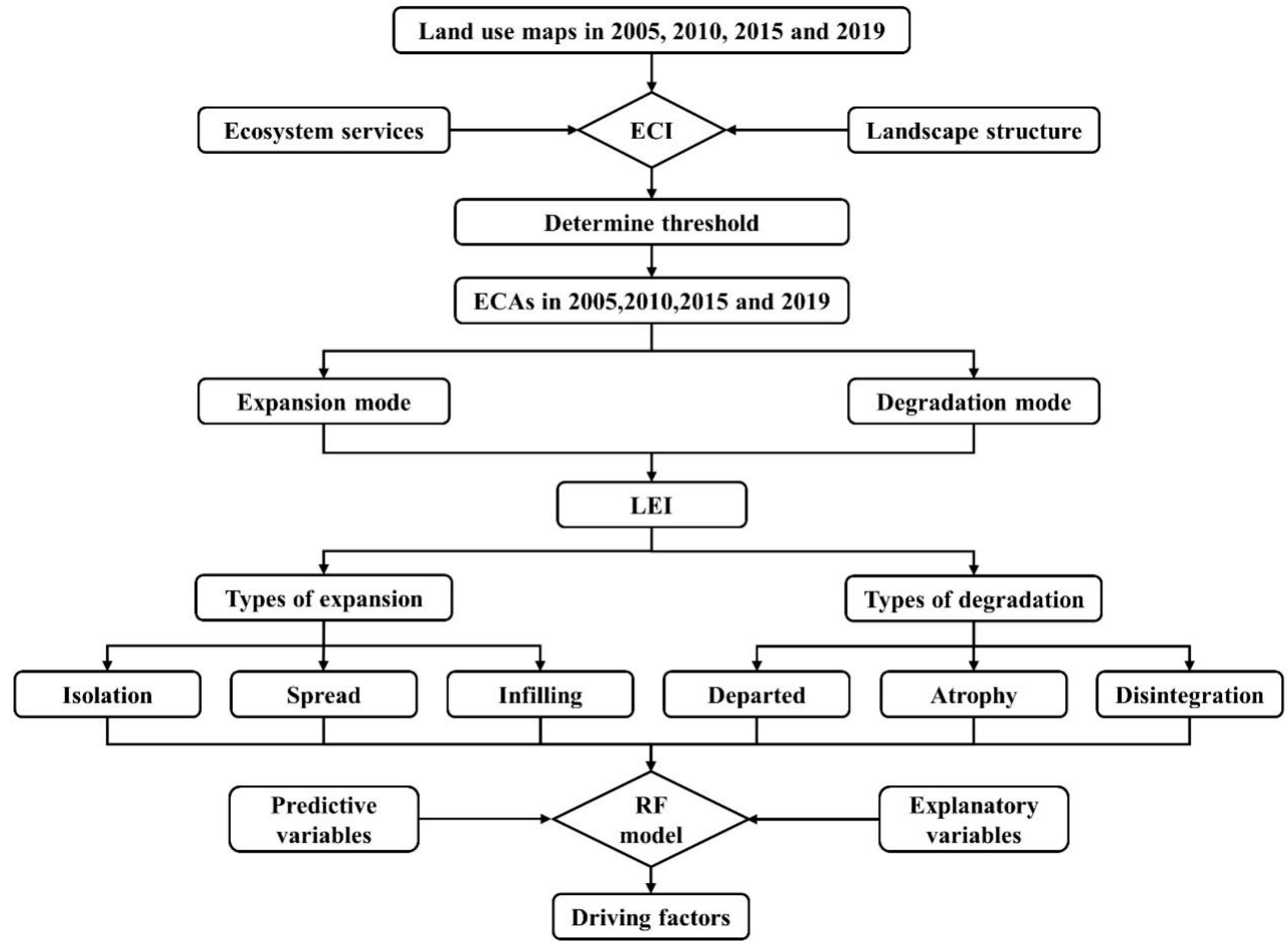

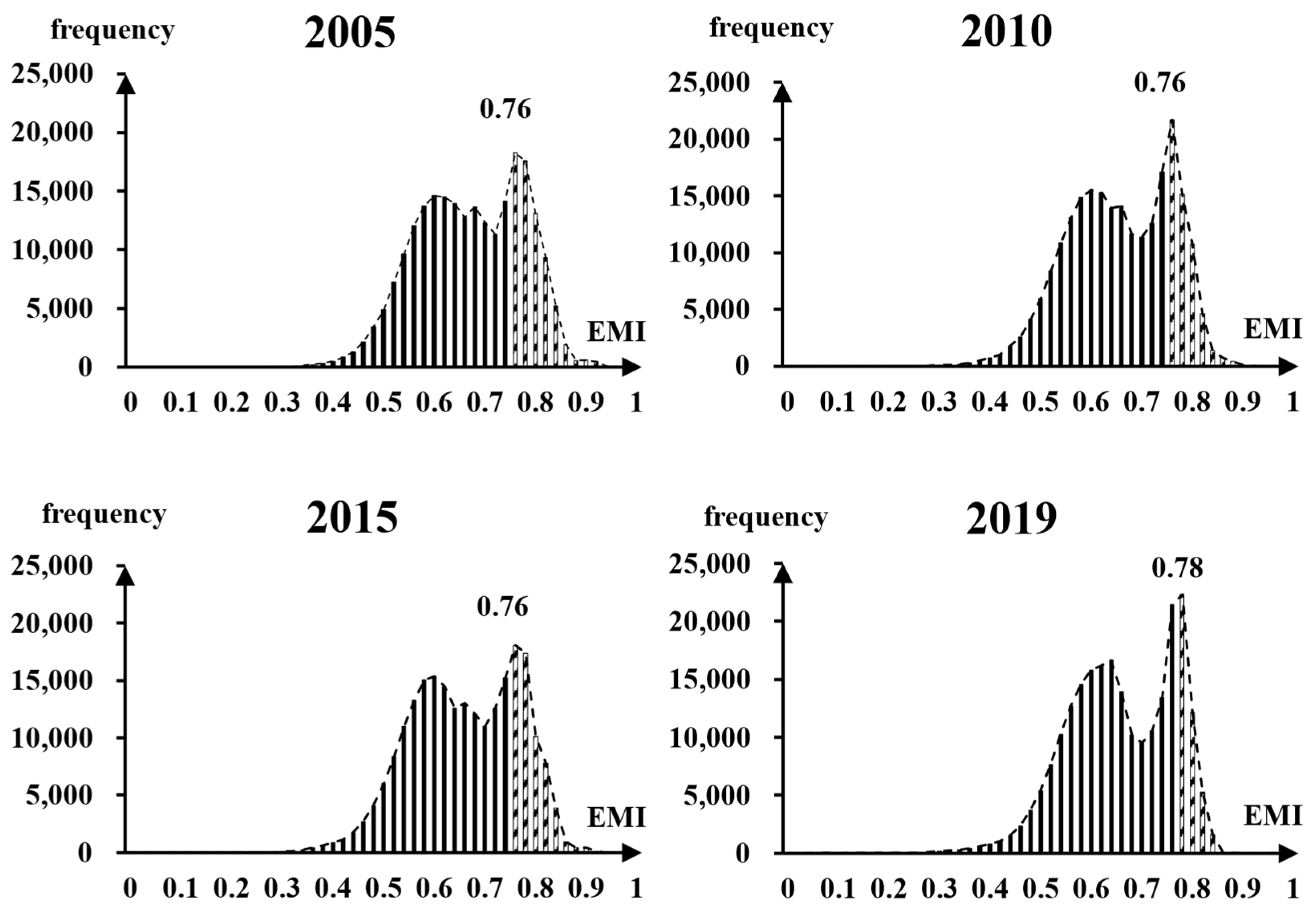
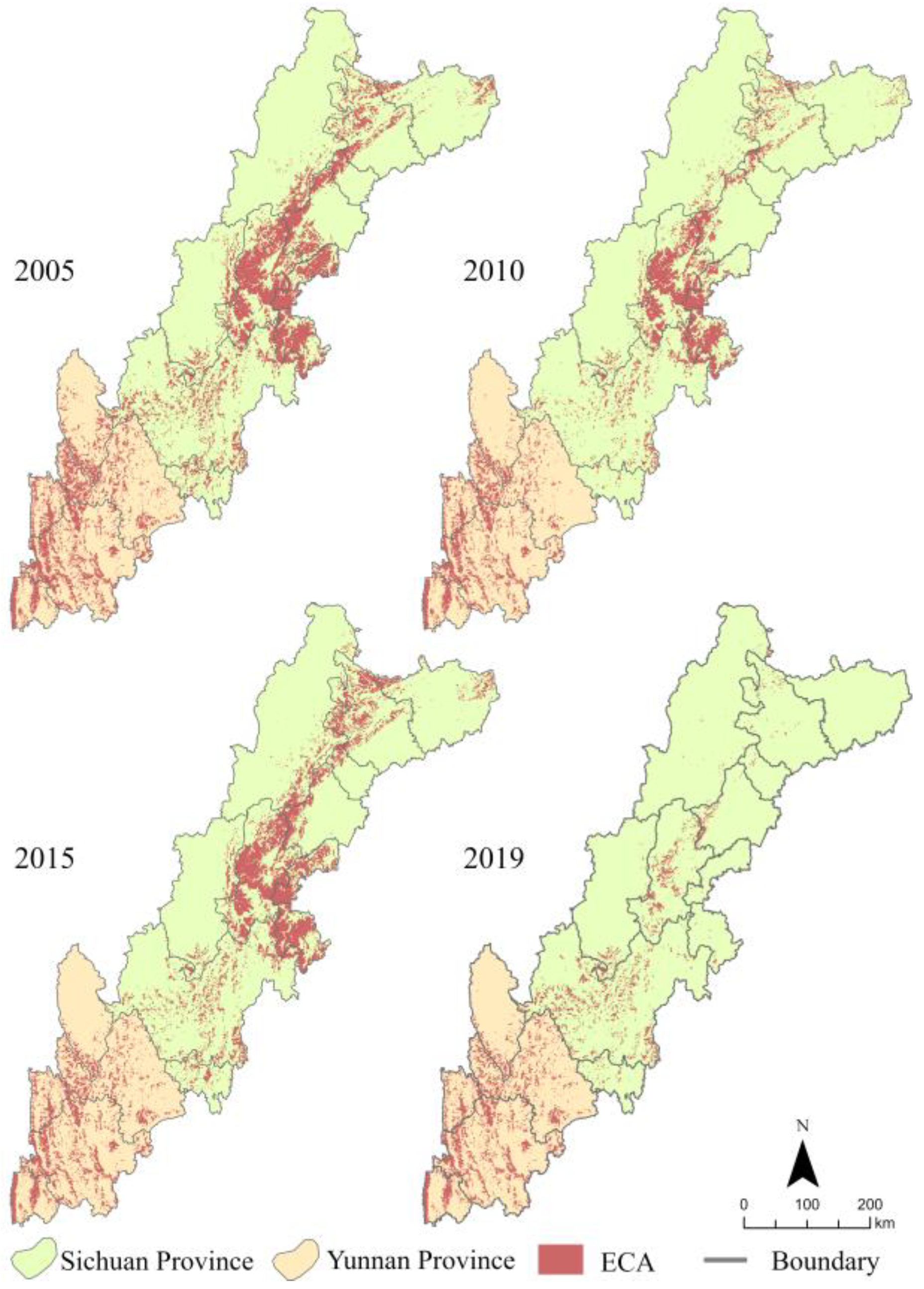

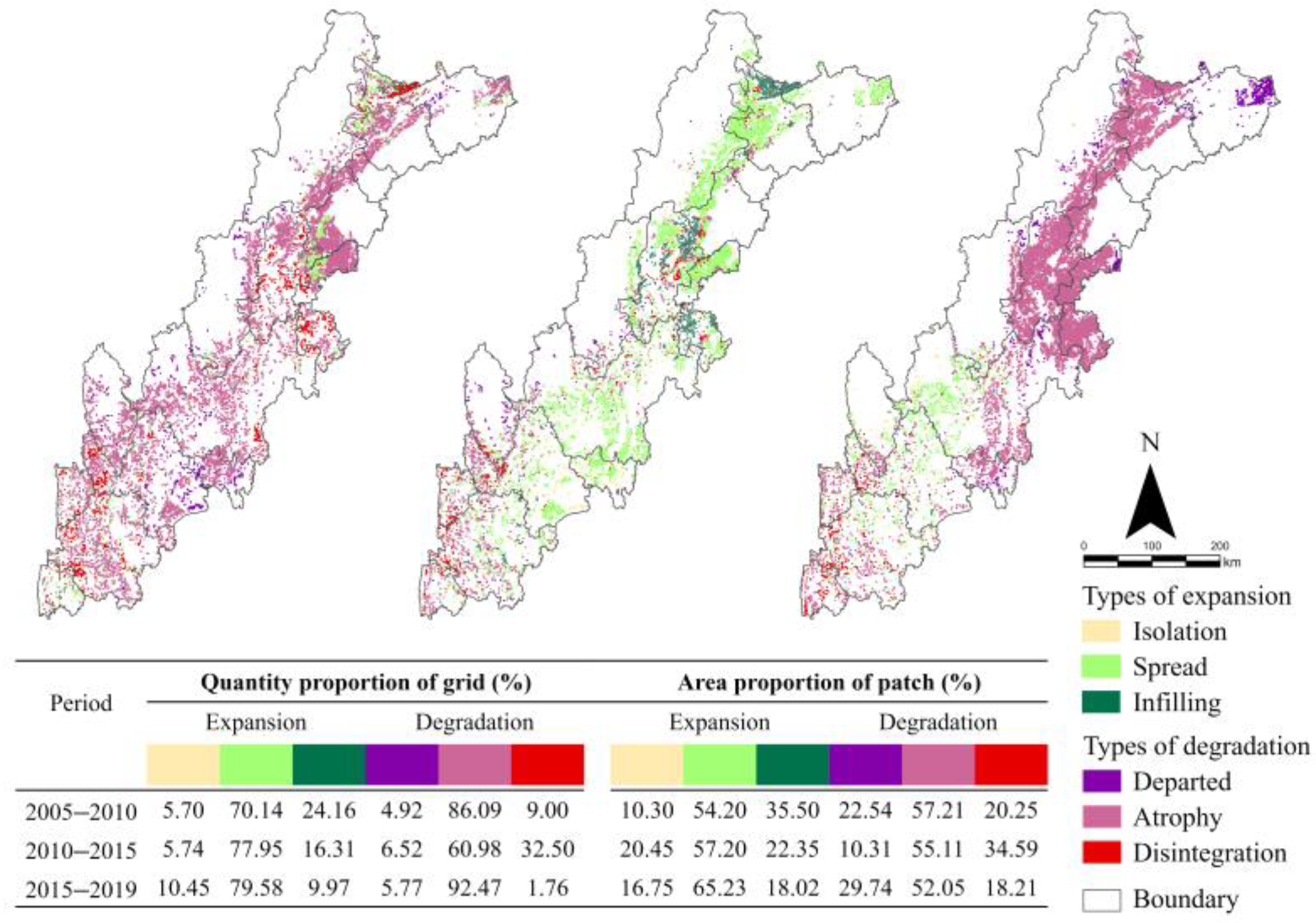
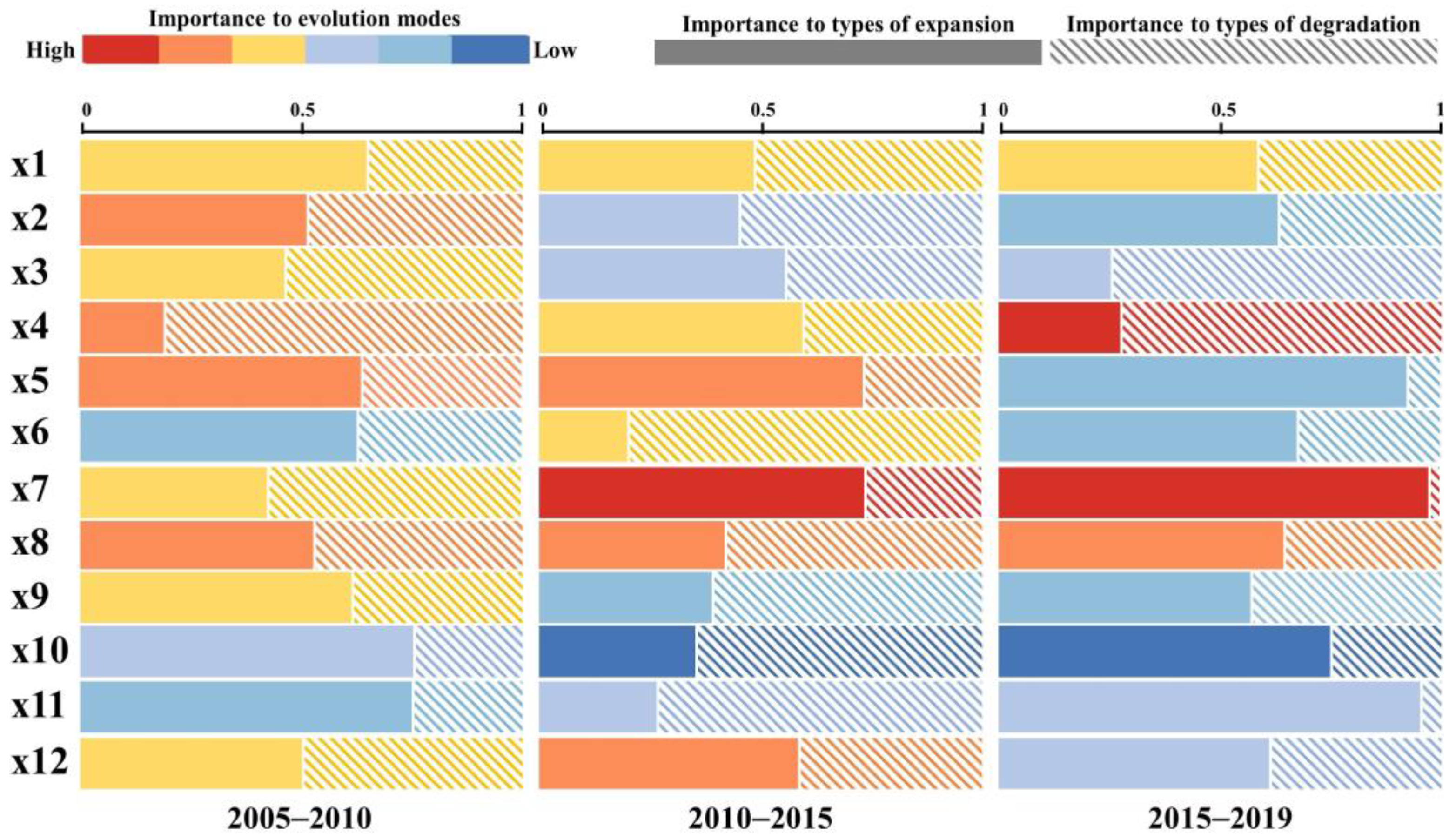
| Data Name | Data Format | Resolution | Data Source |
|---|---|---|---|
| BarrierZoneChina. | shp | / | http://geodoi.ac.cn/ (accessed on 15 March 2021) |
| Land cover data | tif | 30 m | https://zenodo.org/record/5210928 (accessed on 30 March 2021) |
| Digital terrain data | tif | 30 m | http://www.gscloud.cn/ (accessed on 4 April 2021) |
| Meteorological data | nc | 1 km | http://www.geodata.cn/ (accessed on 6 April 2021) |
| Soil data | mdb | 1 km | https://www.fao.org/ (accessed on 6 April 2021) |
| NPP data | tif | 500 m | https://ladsweb.modaps.eosdis.nasa.gov/ (accessed on 6 April 2021) |
| Nightlight data | tif | 1 km | http://data.tpdc.ac.cn/ (accessed on 6 April 2021) |
| Population count | tif | 100 m | https://www.worldpop.org/ (accessed on 8 April 2021) |
| GDP | tif | 1 km | http://www.resdc.cn/ (accessed on 10 April 2021) |
| Factor | Variable | Description | Unit |
|---|---|---|---|
| Environmental condition | x1 | Average altitude | m |
| x2 | Average slope | ° | |
| x3 | Average temperature | °C | |
| x4 | Total precipitation | mm | |
| x5 | Proportion of forest area | km2 | |
| x6 | Proportion of grassland area | km2 | |
| Socioeconomic development | x7 | Proportion of cropland area | km2 |
| x8 | Average GDP | million CNY/km2 | |
| x9 | Population density | number of people/km2 | |
| x100 | Average night light | / | |
| x11 | Euclidean distance from impervious | km | |
| x12 | Euclidean distance from cropland | km |
| Period | Evolution Modes | |||
|---|---|---|---|---|
| Expansion Mode | Degradation Mode | |||
| Count | Proportion | Count | Proportion | |
| 2005–2010 | 1537 | 8.16% | 17305 | 91.84% |
| 2010–2015 | 11248 | 76.90% | 3379 | 23.10% |
| 2015–2019 | 2271 | 8.54% | 24335 | 91.46% |
| Period | Evolution Modes | Types of Expansion Mode | Types of Degradation Modes |
|---|---|---|---|
| 2005–2010 | 92.86% | 72.50% | 86.08% |
| 2010–2015 | 82.19% | 79.01% | 68.86% |
| 2015–2019 | 97.96% | 82.83% | 94.75% |
| Statistics | Max | Min | Mean |
| 97.96% | 68.86% | 83.98% |
Publisher’s Note: MDPI stays neutral with regard to jurisdictional claims in published maps and institutional affiliations. |
© 2022 by the authors. Licensee MDPI, Basel, Switzerland. This article is an open access article distributed under the terms and conditions of the Creative Commons Attribution (CC BY) license (https://creativecommons.org/licenses/by/4.0/).
Share and Cite
Shi, X.; Zhao, X.; Pu, J.; Huang, P.; Gu, Z.; Chen, Y. Evolution Modes, Types, and Social-Ecological Drivers of Ecologically Critical Areas in the Sichuan–Yunnan Ecological Barrier in the Last 15 Years. Int. J. Environ. Res. Public Health 2022, 19, 9206. https://doi.org/10.3390/ijerph19159206
Shi X, Zhao X, Pu J, Huang P, Gu Z, Chen Y. Evolution Modes, Types, and Social-Ecological Drivers of Ecologically Critical Areas in the Sichuan–Yunnan Ecological Barrier in the Last 15 Years. International Journal of Environmental Research and Public Health. 2022; 19(15):9206. https://doi.org/10.3390/ijerph19159206
Chicago/Turabian StyleShi, Xinyu, Xiaoqing Zhao, Junwei Pu, Pei Huang, Zexian Gu, and Yanjun Chen. 2022. "Evolution Modes, Types, and Social-Ecological Drivers of Ecologically Critical Areas in the Sichuan–Yunnan Ecological Barrier in the Last 15 Years" International Journal of Environmental Research and Public Health 19, no. 15: 9206. https://doi.org/10.3390/ijerph19159206






